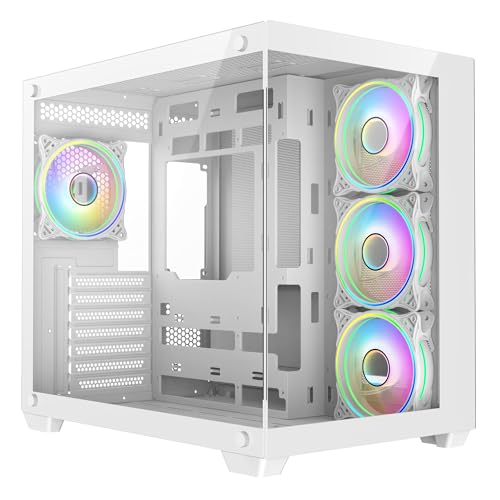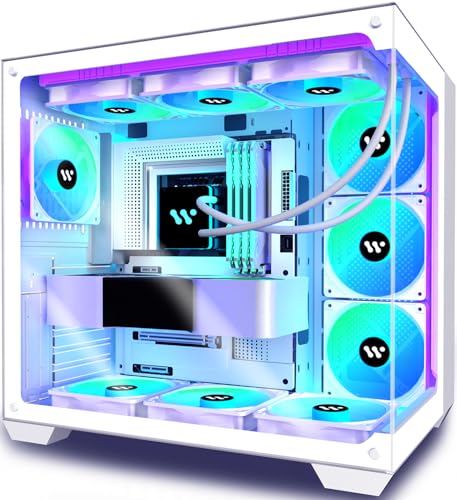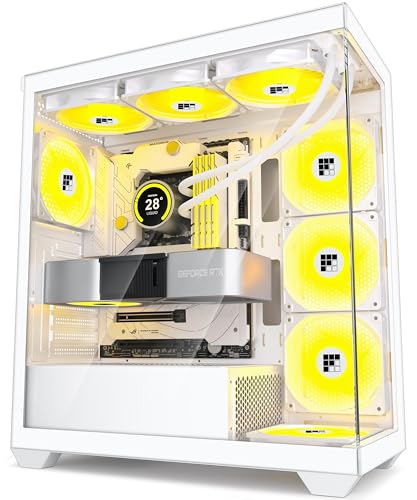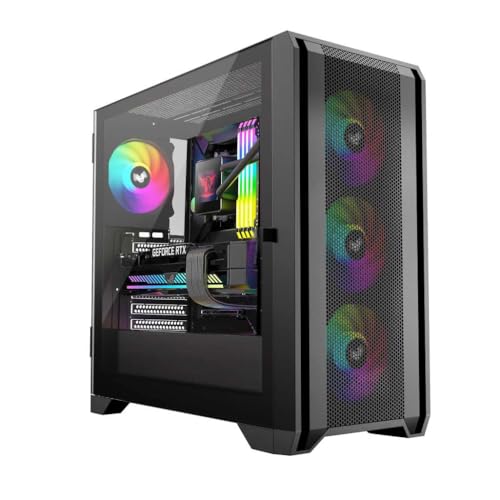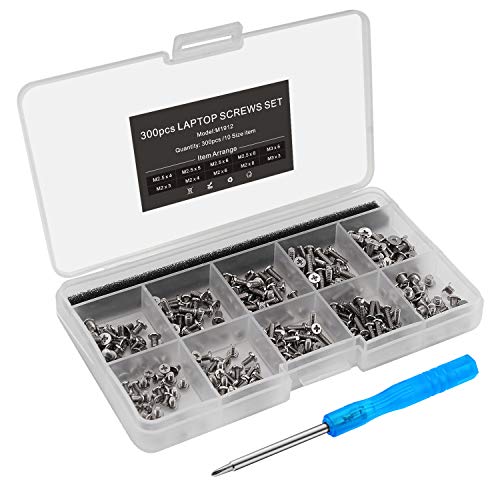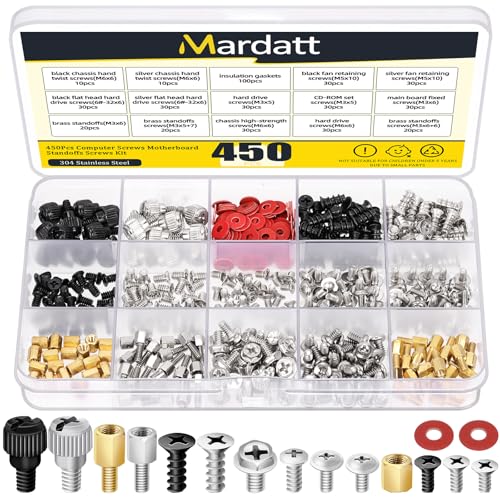Computer Cases
Computer cases keep your components cool, quiet, tidy, and protected while showing off your build style. Since 1988 our UK based online shop has helped builders choose the right PC case for airflow, water cooling, silence, compact desks, and showcase rigs, with clear compatibility advice, fast UK delivery, and easy returns.
Pick a case size that fits your motherboard, graphics card length, and cooler height. Choose a mesh front for airflow, allow space for a 240, 280, 360, or 420 mm radiator if needed, get a front USB-C, and plan two or three quality intake fans with dust filters. Always check GPU length and thickness, CPU cooler height, and PSU length before you buy.
Why buy computer cases from us
UK retailer since 1988 with friendly, expert guidance
Curated range across ATX, Micro ATX, Mini ITX, and E ATX
Clear fit notes for GPU length, air cooler height, radiator support, and PSU length
Airflow tested picks with mesh fronts, quality dust filters, and quiet fan options
Fast UK delivery, simple returns, and accessories like fans, risers, and RGB hubs
Case sizes and types at a glance
| Case type | Motherboard fit | Best for | Key points |
|---|---|---|---|
| Full tower | ATX, E ATX, some SSI | Extreme builds and multi radiators | Many drive bays and space for 360 to 420 mm rads |
| Mid tower | ATX, Micro ATX, Mini ITX | Most gaming and creator PCs | Best balance of size, airflow, and price |
| Micro ATX | Micro ATX, Mini ITX | Compact desks and budget builds | Smaller footprint, check GPU and PSU length |
| Mini ITX | Mini ITX only | Small form factor and travel | Tight clearances, plan airflow carefully |
| Cube or HTPC | Micro ATX or Mini ITX | Living rooms and horizontal layouts | Side intake options, watch cooler height |
Key features to look for
Airflow design: Mesh or perforated front, open intakes, full length dust filters
Cooling support: Top, front, and bottom fan mounts, radiator support for 240, 280, 360, 420 mm
Clearances:
CPU cooler height in mm
GPU length and thickness in slots, especially for triple fan cards
PSU length and space for cables under the shroud
Build quality: Sturdy steel, tempered glass, rolled edges, quality thumbscrews
Ease of build: Tool free panels, hinged glass, preinstalled standoffs, cable channels and velcro straps, and grommets
Front I O: USB C, USB A, audio, power, and reset where needed
Noise control: Rubber feet, padded panels, low turbulence fan paths
Aesthetics: Black or white finishes, tempered glass, clean cable runs, tasteful RGB with hub support
Vertical GPU option: Bracket support and PCIe 4.0 or 5.0 riser compatibility if you plan to show the card
Computer case buying guide
1) Match cooling to your parts
High power GPUs and CPUs need a mesh front and at least two 140 mm or three 120 mm intake fans
For AIO liquid cooling, check front and top radiator sizes and RAM or VRM heatsink clearance
Air coolers need clear height and a front intake path free of solid panels
2) Plan pressure and fan layout
Aim for slight positive pressure with more intake than exhaust to reduce dust
Typical layouts
Front intake 2×140 or 3×120
Rear exhaust 1×120
Top exhaust 2×120 or 2×140 if temps need it
3) Check the numbers before you buy
GPU length, including power cable bend radius
Slot thickness for the GPU, for example, 2.5 or 3.5 slots
Cooler height in mm for tower coolers
PSU length plus room for cables and any front mounted radiator
4) Storage and expansion
2.5 inch and 3.5 inch bay count for SSDs and HDDs
Extra M.2 storage reduces the need for many bays
Room for add-in cards and vertical GPU brackets if required
5) Noise vs airflow
Mesh fronts move more air with less fan speed
Solid or padded panels are quieter at idle but may raise load temps
Use larger 140 mm fans where possible for lower noise at the same airflow
Quick picks by scenario
Cool and quiet gaming ATX: Mesh mid tower with 3×120 or 2×140 front intake, 360 mm front AIO or tall air cooler
Compact Micro ATX value: Breathable front, 2×120 intake, space for a 300 mm GPU
Showcase build: Dual chamber case with tempered glass, vertical GPU kit, RGB hub
Creator workstation: Full tower with top 360 mm rad, many SSD mounts, strong cable routing
SFF Mini ITX: 12 to 14 litre case, short GPU or AIO support, plan cables and low noise fans
Popular sub categories
ATX mid tower cases
Full tower cases
Micro ATX cases
Mini ITX and SFF cases
Silent and sound damped cases
Tempered glass and showcase cases
Vertical GPU brackets and PCIe risers
Case fans 120 mm and 140 mm
RGB hubs, fan controllers, and dust filters
Expert tips and common mistakes to avoid
Do not buy a closed front case for a hot GPU and CPU combo
Measure GPU length with cables and check top radiator clearance over tall RAM or heatsinks
Budget for extra quality fans rather than relying on basic stock fans
Avoid negative pressure without fine mesh filters, or you will pull in dust
Use shorter or angled power connectors to avoid pressing on the glass panel
Secure heavy GPUs with a support bracket to prevent sag
Keep cables behind the PSU shroud and use the supplied straps for tidy airflow
If you plan a vertical GPU, use a certified PCIe 4.0 or 5.0 riser and leave space from the glass
Clean filters often if you have pets or carpets
Plan future upgrades so you do not outgrow radiator or GPU space
Care and maintenance
Vacuum or brush front, bottom, and top filters every few weeks
Wipe tempered glass with a microfibre cloth and approved cleaner
Check fan bearings for noise and replace worn units
Reseat loose cables and tighten thumbscrews after moving the PC
Keep the case off the carpet and leave space behind for the exhaust
Replace thermal paste on CPU and clean dust from the heat sinks every year or two
FAQs. Computer cases
1) What size computer case do I need
Match the case to your motherboard and parts. ATX mid towers suit most builds. Full towers fit E ATX and large radiators. Mini ITX cases are for very small systems.
2) Do mesh front cases really run cooler
Yes. Mesh fronts allow more intake air at lower fan speeds, which reduces temperatures and noise.
3) How many fans should I use
Start with two intakes and one exhaust. Add a top exhaust if GPU or CPU temps are high.
4) Will my graphics card fit
Check GPU length, thickness in slots, and power cable clearance against the case specification. Many modern cards are long and thick.
5) Can I mount a 360 mm radiator in any mid tower
Not always. Confirm the front and top radiator support and the space around the RAM and motherboard heatsinks.
6) What is positive pressure, and why does it matter
More intake airflow than exhaust creates positive pressure, which helps keep dust from entering through gaps.
7) Do I need front USB C
It is very useful for fast external drives and modern accessories. Make sure your motherboard has a USB C front header.
8) Are tempered glass cases safe
Tempered glass is strong and scratch resistant. Handle panels with care and avoid overtightening screws.
9) How do I make a quiet PC case setup
Use mesh for low fan speeds, larger 140 mm fans, rubber mounted drives, and avoid turbulent airflow paths.
10) Will a large air cooler fit my case
Check cooler height in mm and compare to the case limit. Many mid towers support around 165 to 170 mm coolers.
11) Can I use a vertical GPU mount
Yes, if your case provides slots or a bracket. Use a quality PCIe 4.0 or 5.0 riser and leave a gap from the glass for airflow.
12) What is the best case for water cooling
Choose a case with top and front radiator support, a spacious interior, pump or reservoir mounts, and good dust filtration.
13) How many drive bays do I need
If you rely on M.2 NVMe, you may only need one or two 2.5 inch bays. NAS users or local media hoarders may want 3.5 inch bays.
14) Do I need a PSU shroud
A shroud hides cables and improves airflow by isolating PSU heat. It also gives space to tuck cables neatly.
15) Can I mount the PSU fan up or down
Usually fan down to draw air from below through a filtered intake. Use fan up only if the bottom vent is blocked.
16) Why are my temps high in a solid front case
Restricted intake. Add side or bottom intakes if available, or choose a mesh front case.
17) Are sound damped cases worth it
Good for office or bedroom PCs. They trade a little airflow for lower noise. Add extra intakes to compensate.
18) How do I stop GPU sag
Use the included support bracket if provided or a third-party brace. Route power cables with gentle support.
19) What screws and standoffs do I need
Most cases include motherboard standoffs preinstalled and screws for drives and fans. Check the accessory pack in the box.
20) How do I keep the inside dust-free free
Maintain slight positive pressure, use fine mesh filters, and clean them regularly.
Ready to build
Explore computer cases across ATX, Micro ATX, Mini ITX, and E ATX with mesh airflow, tempered glass, silent panels, and water cooling support. With clear fit notes, quality accessories, and trusted UK service since 1988, you can build a cooler, quieter, and better-looking PC.
Halloween or Christmas, this is where you will find all of our Seasonal Products
Hiking or Walking this Winter, here are our Outdoor Clothing Products
Amazon Associate Disclosure
As an Amazon Associate, the Yorkshire Outdoor Activity Park may earn a small commission from qualifying purchases. Please know that this does not affect reviews, content, or this site's opinions of products, services, manufacturers, partners, or merchants. The mission of the Yorkshire Outdoor Activity Park is to provide the best functionality for this site's users, regardless of any potential affiliate commissions.



